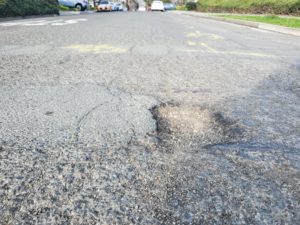
The Benicia City Council unanimously approved $9.2 million in funding for road improvement projects over the next two years at the Feb. 18 meeting. Pictured is a pothole on W. 3rd and W. I St. 46 percent of Benicia’s roads are currently failing, according to a report from the Metropolitan Transportation Commission.
(This article was originally published in the Feb. 21 print edition of the Herald)
Galen Kusic, Editor
It is well known that Benicia’s roads are in need of a serious makeover.
At the Feb. 18 City Council meeting, the council unanimously approved the two year street and road repair funding request for the 2019-20 and 2020-21 paving seasons. This also includes the Park Road Improvement Project for an investment totaling around $9.2 million, according to City Manager Lorie Tinfow.
The need for these repairs was found through a report compiled by the Metropolitan Transportation Commission, which outlined the overall rating of street conditions and how much funding was needed to improve the City’s Pavement Condition Index (PCI).
The PCI is a measurement of pavement conditions and ranges from 0-100. The City’s overall PCI is currently 54. Failed streets have a PCI of 25 or less. About 46 percent of Benicia’s streets currently have a poor of failing score.
The Park Road Improvement Project was approved in June 2017, and $976,000 has already been appropriated. Through gas tax funds, a $2.4 million grant from the Solano Transportation Authority and $2.8 million from Measure C sales tax revenue, the $5.7 million needed for the project is now available.
The Council also decided to double the amount of funding toward microsurfacing and resurfacing projects from $2.3 million in 2017-2019 to $4.8 million in the current cycle. According to a report from Public Works, the City continues to allocate more funding each year for road repairs.
“It has a safety aspect, as well as a quality of life aspect,” said Public Works Director William Tarbox. “I think we can all recognize this is a high quality asset that needs to be remedied in the City. It affects every single individual who lives and or works in the city of Benicia.”
Tarbox explained that the Pavement Management Program (PMP) evaluates cost and various pavement treatments. Streets selected for treatment are selected through a combination of factors including assigning importance ratings for road segments based on traffic volumes, road functional class and community demand.
“It is a data driven process,” said Tarbox.
Councilmember Tom Campbell requested reassurance that all of Measure C funds would not be spent on this project. City staff explained that over $1 million would remain unappropriated before the next cycle of Measure C funds comes in, which usually totals around $5 million annually.
Tarbox explained that the City keeps a database from public input about the condition of roads, and the city engineer goes out to verify which roads are actually in the worst shape. The priority for repairs will be based on the worst PCI rankings.






What about repaving reservoir road off 2nd st. And lake Herman rd. Towards Vallejo. These are 2 very busy areas that are in terrible shape. The city just fills the POT HOLES which doesn’t do any good.
One of these days there will be a terrible accident because of those roads.
Yes, it an accident waiting to happen. It’s going to kill somebody sooner or later.